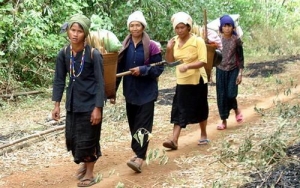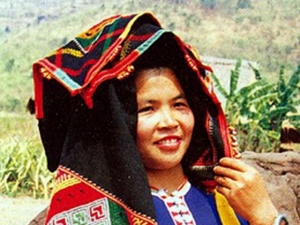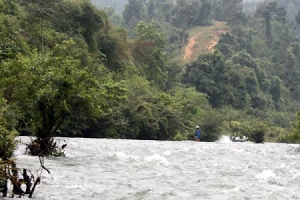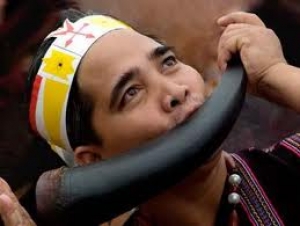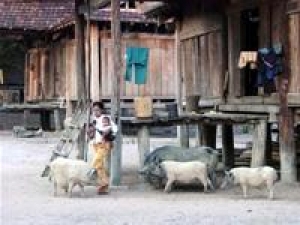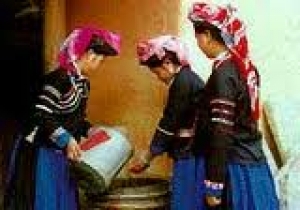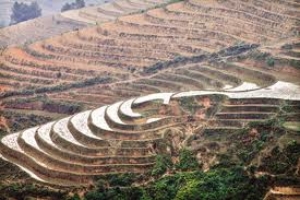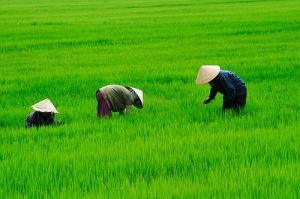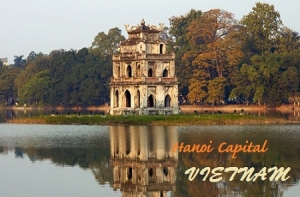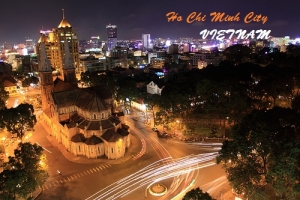
Asia Pacific Travel Team
Enjoy to space of festival in the Xtieng ethnic group
Name of ethnic group: Xtieng (Xa Dieng)
Population: 66,788 people (Year 1999)
Locality: The Xtieng live in four northern districts of Binh Phuoc Province and in Dong Nai and Tay Ninh provinces.
Customs and habits: The Xtieng live a sedentary lifestyle. Each family builds its own house. Each village is led by an elderly man who must be experienced in the affairs of the community, dynamic, and trusted by the villagers. The Xtieng can marry outside their lineage. After the wedding, the bride comes to live in her husband's house. The Xtieng believe in animism and the mystical powers of thunder, lightning bolts, the heavens, and the earth. The Xtieng calculate their age according to the number of harvests that they have gathered.
Culture: The Xtieng language belongs to the Mon-Khmer Group. The Xtieng enjoy music and popular musical instruments, such as the six-patterned gong set. These gongs are made of bamboo panpipes.
Costumes: Xtieng women wear skirts and the men wear loincloths. In winter, they cover themselves in blankets. The women wear their hair long and tie it in a bun at the back of their heads. They usually wear ivory earrings pierced into their earlobes, or tattoo their faces and body with simple motifs.
Economy: The Xtieng cultivate rice in submerged fields and have used oxen and buffaloes as draught animals for a long time.
The spicific culture of Xi Mun ethnic group
Name of ethnic group: Xinh Mun (Puoc, and Pua)
Population: 18,018 people (Year 1999)
Locality: Son La and Lai Chau provinces and along the Vietnamese-Lao border regions.
Customs and habits: Xinh Mun houses are built on stilts, have vaulted roofs shaped like a tortoise shell and stairways at both ends of the house. The children take the family name of the father. After the death of the father, the eldest brother is elevated to an important position.
According to marriage customs, the family of the groom must give money to the bride's family. After the proposal, engagement, and wedding, the husband goes and lives with his wife's family. A few years later, when the married couple has a few children, the wife is then welcomed to her husband's house. The couple must change their name and take another name given by the mother-in-law's younger brother. It is the habit of the Xinh Mun to chew betel nut, dye their teeth black, and drink alcohol.
During the production of rice, people hold many ceremonies and maintain many taboos. The villagers annually organize a ceremony to honour the spirit of the village. Culure: The Xinh Mun language belongs to the Mon-Khmer Group.
Culure: The Xinh Mun language belongs to the Mon-Khmer Group.
Costumes: They wear garments that resemble the Thai and Lao.
Economy: The Xinh Mun grow glutinous rice and corn on burned land and terraced fields. They also gather, rear animals, hunt, make basketry articles, and have developed a system of bartering goods.
The Dan Lai ethnic group - The dream among jungle
Name of ethnic group: Tho (Keo, Mon, Cuoi, Ho, Tay Poong, Dan Lai, and Ly Ha)
Population: 68,394 people (Year 1999)
Locality: The Tho live in the western parts of Nghe An Province.
Customs and habits: Formerly, the Tho lived in houses built on stilts. Now they prefer houses built on the ground. Close relationships and a desire to help each other have existed for a very long time in Tho society. Young Tho boys and girls have enjoyed considerable freedom through a custom known as "Ngu Mai". They are allowed to lie together and have heart-to-heart talks with each other. In the course of these nocturnal parties, each boy and girl will eventually find their sweetheart. As for marriage, a boy's family must spend a lot of money in preparation for the celebration of the wedding. Therefore, a boy must work many days for his future in-laws. The Tho worship innumerable genies and spirits. They also have great respect for pioneers who have made contributions to the clearing of the land and the building of the village, and for the numerous war heroes. All families also worship their ancestors. Each year, the most important ceremony called "Going to the Field" is held.

Culture: The Tho language belongs to the Viet-Muong Group.
Costumes: Tho attire resembles the farmers dress of the Kinh in the early half of 20th century. Tho women buy skirts from the Thai and wear a square white cloth around their heads which serves as a female head dress. The morning ribbon is a long white piece of cloth.
Economy: The Tho cultivate rice and hemp. With rice cultivation, they often use ploughs and harrows to till the soil. Hemp is grown primarily for producing items for daily use. The forest provides various kinds of vegetable for Tho daily life.
Find out the culture and life of Ta Oi ethnic group
Name of ethnic group: Ta Oi (Toi Oi, Pa Co, Ba Hy, and Ba Ghy)
Population: 34,960 people (Year 1999)
Locality: A Luoi District of Thua Thien-Hue Province and Huong Hoa District of Quang Tri Province.
Customs and habits: The communal house of the Ta Oi is called the Rong. It is built at the centre of the village and is a fairly elongated house. The children take the family name of the father and only sons have the right to inherit the family estate. The head of a lineage plays an important role in village affairs. Young Ta Oi men and women are free to choose their partners. They believe in animism and organize many ceremonies for Giang. Several years after the burial of a deceased person, the dead's lineage organizes a ceremony to exhume the dead's remains and build a funeral house with sophisticated decoration and statues around the fence of the funeral house.
Culture: The Ta Oi language belongs to the Mon-Khmer Group and is close to the Bru-Van Kieu and Co Tu languages. The Ta Oi have managed to preserve many of their proverbs, folk songs, puzzles, and stories. Popular folk songs include Ka loi, Ba boih, Ro in, and especially the romantic Cha Chap song. Gongs, string zithers, flutes, trumpets, drums, and pan-pipes are popular musical instruments of the Ta Oi.Costumes: Women wear shirts and skirts, but the skirt is usually knotted up to cover their chests. Men wear loincloths and short vests, or leave their upper torsos naked. Ornaments made from copper, silver, glass beads, and ivory are also popular.
Economy: The Ta Oi practice a slash-and-burn method of cultivation and grow wet rice through this process. They are also good at horticulture and fish rearing in artificial ponds.
The Ro Mam ethnic group - The wild beauty among jungle
Name of ethnic group: Ro Mam
Population: 301 people (Year 1999)
Locality: The Ro Mam live in Le Village, Mo Rai Commune, Sa Thay District of Kon Tum Province.
Customs and habits: The village of the Ro Mam is called a "de". It is headed by an old chief. Each family is comprised of 10-20 people of various generations who have blood ties and who live under the same roof. Each nuclear family forms its own economic unit. The Ro Mam's matrimonial rites are performed in two steps, the engagement phase and wedding phase. Several days after the wedding, a young couple may divorce. However, once they have lived together for a long time they are not allowed to divorce. When a person dies, their body is placed in the cemetery. The cemetery is always located at the west end of the village.
Culture: The Ro Mam language belongs to the Mon-Khmer Group Rituals and ceremonies are usually held during the production cycle from the start of the slashing of the field until the land is set on fire, and eventually when the rice is brought to the house. These communal village activities have been preserved to the present day.Costumes: Women wear skirts and short sleeved shirts. The skirts are made from coarse cloth without decorations, and they fall down below their knees. Men wear loincloths, where the front flap hangs over their knees and the back flap falls below their shins. Women like to wear earrings, bracelets, and necklaces made from glass beads.
Economy: The Ro Mam survive mainly from slash-and-burn cultivation, hunting, and gathering. Sticky rice is their staple food.
Discover culture of the Pu Peo ethnic group
Name of ethnic group: Pu Peo (Ka Beo, Penti, and Lo Lo)
Population: 705 people (Year 1999)
Locality: Concentrated along the Sino-Vietnamese border in Dong Van, Yen Minh, and Meo Vac districts of Ha Giang Province.
Customs and habits: Houses are usually built on the ground in tiny clusters be side a Hoa or H'Mong village. Each family lineage has its own system of middle names. Pu Peo society follows a patriarchal system, as the father or husband has the right to own the house. The Pu Peo attach great importance to ancestral worship. Small earthen jars, each symbolizing a generation, are often placed on their altar.Culture: The Pu Peo language resembles that of the Co Lao, La Chi and La Ha, and belongs to the Kadai Group. The Pu Peo hold ceremonies to pray for peace and the beginning of the new working season. This particular ceremony is held during the New Year in the first half of the first lunar month, and continues to the fifth day of the fifth lunar month. The Pu Peo are one of few ethnic groups still using bronze drums. In Pu Peo custom, male and female drums sets exist.
Costumes: The attire of Pu Peo women still maintain their vibrant colours as pieces of different coloured cloths are sewn to make colourful designs. They wear scarves, skirts, vests, and aprons. The men, however, dress like other ethnic groups in the region.
Economy: The Pu Peo farm on burned land and terraced fields, growing maize, rice, rye, and beans. Their farm tools include ploughs and harrows. They use buffaloes and oxen to serve as draught animals. Their staple food is steam cooked corn flour.
The Phu La ethnic group and unique clothing characteristic
Name of ethnic group: Phu La (Xa Pho, Bo Kho Pa, Mu Di Pa, Pho, Va Xo and La Dun Dang)
Population: 9,046 people (Year 1999)
Locality: Lai Chau, Son La, Lao Cai, and Ha Giang provinces. The largest settlements are in Lao Cai Province.
Customs and habits: The Phu La worship their ancestors and believe in animism. They live in various villages, each village containing about 10-15 households. The house is built very simply with three rooms and a thatched roof. The oldest men, the village chiefs, and the lineage heads play a significant role in managing public affairs. The young people are not forced to marry. After an engagement the bride comes to live with her husband's family; the wedding, however, may be held one or two years later.
Culture: The Pu La language belongs to the Tibeto-Burman Group.Costumes: Men's garments have unique characteristic such as an open shirt with many glass beads and figures that are arranged in a cross shape. Women's dresses are embroidered with many colourful motifs. The women often wear square aprons that are embroidered with motifs and attached with glass beads sewn in parallel lines or in an eight tipped star pattern.
Economy: The Phu La depend on farming using the slash-and-burn method and planting on terraced fields. They rear buffaloes, horses, and pigs. Basketry is another form of income and they are well known for their beautifully decorated bamboo and rattan articles. The Phu La often sell or barter articles for other commodity goods from other ethnic groups.
Vietnam country, with remarkably varied and complex Geography
Topography
Vietnam has five main land regions. The North consists of the Northern Highlands and the Red River Delta, and the South is made up of the Annamite Mountain Range, the Coastal Lowlands, and the Mekong Delta.
It has a sizeable mountain range in the northwest (an offshoot of the Himalayas), heavily forested uplands, extensive limestone scenery with several areas of mature ‘Karst’ landscape, an elevated central plateau, two large river deltas and thousands of offshore islands.
Although all this makes life difficult for most of the 70% of the population that still work the land, it has great benefits for visitors in the form of a wide variety of landscapes.
Lush green paddy patchworks, vertiginous mountain terracing, tea and coffee plantations, pepper and pineapple fields, salt pans, flood dykes and drainage canals: the ways in which the people have adapted the land to agriculture with the beauty of the natural landscapes for the photographers’ attention.
From a visitor’s point of view, such geographical diversity is part of Vietnam’s attraction. Icy mountain streams and boiling hot mineral springs, sheer cliffs to challenge even the best rock climber, deep caves and underground rivers, many unexplored, serene freshwater lakes, white sand beaches – Vietnam has all this, and much more.
Various Bio-diversity
Vietnam’s wide range of fauna, flora and marine species places it in the top ten countries for the variety of its bio-diversity. Large National Parks, forests and marine coastal zones are home to some of the most endangered species in the world, and are often unique to Vietnam. Elephants, tigers, rhinoceros, black bears,crocodiles are some of the larger species still living in remote areas.
Several of Vietnam's forests and wetlands are rich in birdlife, with many rare species.

Aquatic and semi-aquatic species include large pelagic fish and mammals, such as dolphins, sharks, rays and the occasional whale. Turtles and dugongs visit some of the more remote islands in the south. Corals and marginal plant species such as mangroves and sea-grasses can be seen in many locations.
Plant life varies from rhododendrons and deciduous trees in the mountainous north, cactus plants and pines in the dry central areas, dripping vines, exotic orchids and ancient trees in the primitive forests, and lush palms and fruits in the tropical south.
HANOI CAPITAL
HANOI CAPITAL
Square: 3344,6 km2 ; Population: 6561,9 thousands people (2010)
Districts: Hoan Kiem, Ba Dinh, Dong Da, Hai Ba Trung, Tay Ho, Thanh Xuan, Cau Giay, Long Bien, Hoang Mai, Dong Anh, Soc Son, Thanh Tri, Tu Liem, Gia Lam, Ha Dong, Son Tay, Ba Vi, Phuc Tho, Dan Phuong, Thach That, Hoai Duc, Quoc Oai, Chuong My, Thanh Oai, Thuong Tin, My Duc, Ung Hoa, Phu Xuyen, Me Linh.
OVERVIEW:
Hanoi, literally the “city between the rivers”, is the capital and second biggest city of Viet Nam. The historical Old Town, the colonial French Quarter, ancient temples of more than thousand years of age and various scenic lakes and landmarks make up one of the most fascinating cities of Southeast Asia, with a mix of Chinese and French influences enriching the vibrant Vietnamese culture.
The compact city centre is bordered by the Red River (Song Hong) to the east as well as to the north and a railway line to the west with the Hoan Kiem Lake nowadays being its focal point of public life and an excellent point of orientation. North of the lake lies Hanoi’s historic heart, the Old Quarter (Phố Cổ Hà Nội). Most of the street names still originate from the 13th century when every guild had its own street, usually called “Hàng” meaning “merchandise” followed by the name of the product, which is produced or sold there. Since at that time the tax depended on the width of the house frontage, the area is famous for its so-called tube houses, buildings with narrow frontages of two to three metres with a length of 20 to 60 metres.
The city’s most prominent sights include the Temple of Literature (Văn Miếu), site of the oldest university in Vietnam dating back to 1070, the One-Pillar Pagoda (Chùa Một Cột), one of Viet Nam’s most iconic temples, the Flag Tower of Hanoi (Cột cờ Hà Nội), one of the few remains of the old Hanoi Citadel and one of the symbols of the city and many museums. Hanoi’s narrow and crowded streets filled with various exotic scents, hawkers weaving through motorbikes and cyclos overloaded with fruits, livestock as well as human cargo create this unique fusion of old and new making it a reflection of the rapid changes the country is recently going through. There’s no better way of exploring this spirit of Hanoi than wandering around the streets, soaking up its sights, sounds and smells.
HISTORY:
Hanoi has been capital of Vietnam for nearly a thousand years, during which the city has endured numerous invasions, occupations, restorations and name changes. The Chinese ruled Hanoi and much of Vietnam off and on for centuries, until a Vietnamese general named Le Loi (the later King Le Thai To) finally secured the nation's independence in 1428. It wasn't until 1831 that the Nguyen Dynasty renamed the city Ha Noi, which can be translated as “Between Rivers” or “River Interior”.
In mid-1800s, Viet Nam was colonized by the French and Ha Noi became capital of French Indochina in 1887. The French administration imposed significant political and cultural changes on Vietnamese society. A Western-style system of modern education was developed, and Christianity was introduced into Vietnamese society. In addition, it was also the development of plantation economies to promote the exports of tobacco, indigo, tea and coffee. The French colonialists largely ignored increasing calls for self-government and civil rights. A nationalist political movement soon emerged, with leaders such as Phan Boi Chau, Phan Chu Trinh, Emperor Ham Nghi and Ho Chi Minh calling for independence.
During the Second World War the Japanese occupied Hanoi and the rest of Viet Nam (1940-1945), exploited the country for its natural resources. With the end of the war, the French resumed control of their colony. In response, Ho Chi Minh launched a liberation movement that led to eight bloody years of war with France. The French finally withdrew in 1954, leaving Vietnam divided in half at the 17th parallel, with Ho Chi Minh's communist Democratic Republic of Vietnam based in the north, and the Republic of Vietnam in the south. It follows the bitter Vietnam War (the American War), during which Ha Noi suffered from heavy bombardments. Ha Noi became the capital of Vietnam when North and South Vietnam were formally reunited in July 1976.
GEOGRAPHY:
Hanoi is located in the Red River Delta, in the center of North Vietnam. It is encompassed by Thai Nguyen Province to the north, Vinh Phuc and Ha Tay to the west and south, Bac Giang, Bac Ninh and Hung Yen provinces to the east and south-east. Hanoi means "the hinterland between the rivers" (Ha: river, Noi: interior). Hanoi's territory is washed by the Red River (the portion of the Red River embracing Hanoi is approximately 40km long) and its tributaries, but there are some other rivers flowing through the capital, including Duong, Cau, Ca Lo, Day, Nhue, Tich, To Lich and Kim Nguu.
CLIMATE:
Climate: Hanoi is situated in a tropical monsoon zone with two main seasons. During the dry season, which lasts from October to April, it is cold and there is very little rainfall, except from January to March, when the weather is still cold but there is some light rain. The wet season, from May to September, is hot with heavy rains and storms. The average annual temperature is 23.2ºC (73.7ºF) and the average annual rainfall is 1,800mm. The average temperature in winter is 17.2ºC (62.9ºF), but can go down to 8?C (46.4ºF). The average temperature in summer is 29.2ºC (84.6ºF, but can reach up to 39ºC (102.2ºF)
TOURISM:
Throughout the thousand years of its eventful history, marked by destruction, wars and natural calamities, Hanoi still preserves many ancient architectural works including the Old Quarter and over 600 pagodas and temples. Famous sites include the One Pillar Pagoda (built in 1049), the Temple of Literature (built in 1070), Hanoi Citadel, Hanoi Opera House, President Ho Chi Minh's Mausoleum...
Hanoi also characteristically contains 18 beautiful lakes such as Hoan Kiem Lake, West Lake, and Truc Bach Lake..., which are the lungs of the city, with their surrounding gardens and trees providing a vital source of energy.
Many traditional handicrafts are also practiced in Hanoi including bronze molding, silver carving, lacquer, and embroidery. Hanoi has many famous traditional professional handicraft villages such as Bat Trang pottery village, Ngu Xa bronze casting village, Yen Thai glossy silk...
TRANSPORTATION:
By road: Hanoi is 93km from Ninh Binh, 102km from Haiphong, 153km from Thanh Hoa, 151km from Halong, 474km from Dien Bien Phu, 658km from Hue, 763km from Da Nang, and 1,710km from Ho Chi Minh City.
By air: Noi Bai International Airport, over 35km from the city center, is one of the biggest airports of the country with various international and domestic routes. There are domestic flights from Hanoi to Da Nang, Dien Bien, Ho Chi Minh City, Hue, Nha Trang and international flights to many countries in over the world.
By train: Hanoi Railway Station is Vietnam's main railway station. It is the starting point of five railway lines leading to almost every province in Vietnam.
Ho Chi Minh City
Square: 2095,5 km2
Population: 7396,5 thousands people (2010)
Districts: District 1, District 2, District 3, District 4, District 5, District 6, District 7, District 8, District 9, District 10, District 11, District 12, Tan Binh, Binh Thanh, Phu Nhuan, Thu Duc, Go Vap, Binh Tan,Tan Phu, Nha Be, Can Gio, Hoc Mon, Cu Chi, Binh Chanh
OVERVIEW:
If you have visited a number of cities in Vietnam but forgot Ho Chi Minh City, you have not known much about Vietnam for real. It is considered the capital of the Southern area of Vietnam. It is located near the Mekong delta, about 1,760 kilometers south of Hanoi, the capital of Vietnam. Ho Chi Minh City is the largest city in Vietnam with the population of more than 7.3 million in the area of 2095.5 square kilometers (908 square miles). Ho Chi Minh City is the second heart and soul of Vietnam, to Hanoi. It's a bustling, dynamic and industrious center, the largest city in the country, the economic capital and the cultural trendsetter. Yet within the teeming metropolis are the timeless traditions and beauty of an ancient culture.
HISTORY:
Ho Chi Minh City (abbreviation HCMC), commonly known as Saigon is the largest city in Vietnam and the former capital of the Republic of Vietnam. The city used to be a small fishing village, inhabited by Khmer people, Cambodia before becoming a land under Nguyen dynasty rule in 1698, being conquered by France from 1950 to 1975. Throughout its long history, HCMC appears to be not only a modern and dynamic city but a cultural and historical one as well.
Following the Fall of Saigon in 1975, Saigon was renamed Ho Chi Minh City. Nevertheless, the old Saigon moniker is still used by both Vietnamese and foreigners.
GEOGRAPHY:
In the core of the Mekong Delta, Ho Chi Minh City, formerly known as Saigon, is second the most important in Vietnam after Hanoi. It is not only a commercial center but also a scientific, technological, industrial and tourist center. The city is bathed by many rivers, arroyos and canals, the biggest river being the Saigon River. The Port of Saigon, established in 1862, is accessible to ships weighing up to 30,000 tons, a rare advantage for an inland river port.
CLIMATE:
The climate is generally hot and humid. There are two distinctive seasons: the rainy season, from May to November, and the dry season, from December to April. The annual average temperature is 27ºC. The hottest month is April and the lowest is December. It is warm all year.
The best time to visit weather-wise is the dry season between December and April, when the humidity is more manageable. The clouds start getting heavy around November and stay through March. The Tet Festival in late January or early February is an exciting, if extremely hectic, time to visit. Being only 10.5° above the equator and between 5 and 10m (16-35ft) above sea level, Ho Chi Minh City is almost a template for tropical weather. Temperatures rarely vary from about 30°C (86°F).
TOURISM:
Being a city embracing both traditional and modern beauty, HCMC is an ideal destination of interest for every generations with different characters.
You are young, active and playful? There are uncountable places of entertainment for you in this fast-growing dynamic city. Dam Sen Water Park is worth your try. Opened in 1999 with new water slides added each year, this water park offers some truly unique water slide experiences (including the amazing "Space Bowl")! Or you may like to watch films? Galaxy cinema with up-to-date films on big screen would be your premium choice. Though not as huge as that in some other countries, it is one amongst the top places of entertainment in Ho Chi Minh City these days.
If you prefer places of religion and history, here we go! Notre Dame Cathedral (Nhà thờ Đức Bà) is the old architectural monument, which is much enchanting. Incense Thien Hau Pagoda is dedicated to Lady Thien Hau, the sea goddess, who left two giant turtles to keep an eye on things in her absence. A festival is held in her honor on the 23rd day of the March lunar month. Don't miss the gorgeous sculptures in the walls of the courtyard outside the temple! Quan Am Pagoda, the oldest pagoda in town, and Phung Son Tu Pagoda, which is dedicated to the God of happiness and virtue. The pagoda itself is dusty and dwarfed by high-rises under construction nearby, but the small, sculpted grounds are a good place for a rest from the hectic city. Besides, you should also visit some premium museums of the city, such as the Ho Chi Minh City Museum, Museum of Vietnamese History, and Revolutionary Museum and the War Remnants Museum.
Further more, HCMC is a city that churns, ferments, bubbles and fumes. The streets are a jumble of street markets, shops, pavement cafes, stands-on-wheels and vendors selling wares spread out on sidewalks. It's impossible not to be infected by its exhilarating vibe.
Today, Ho Chi Minh City is the big tourism center in Vietnam, attracting a large of visitors to Vietnam. Ho Chi Minh City has various attractions as Ho Chi Minh Museum, formerly known as Dragon House Wharf, Cu Chi Tunnels, system of museums, theatres, cultural houses... Recently, many tourist areas are invested such as Thanh Da, Binh Quoi Village, Dam Sen Park, Saigon Water Park, Suoi Tien, Ky Hoa..., which draw numerous tourists
Despite its quite recent past, Ho Chi Minh City nevertheless possesses various beautiful buildings, displaying a characteristic combination of Vietnamese, Chinese and European cultures. These include Nha Rong (Dragon House Wharf), Quoc To Temple (National Ancestors Temple), Xa Tay (Municipal Office), Ho Chi Minh Municipal Theatre as well as many pagodas and churches (Vinh Nghiem, Giac Vien, Giac Lam, Phung Son pagodas...). After more than 300 years of development, Ho Chi Minh City presents many ancient architectural constructions, famous vestiges and renowned sights. It is remarkable for its harmonious blending of traditional national values with northern and western cultural features.
TRANSPORTATION:
Ho Chi Minh City is the main junction for trains, roads, water, and air transportation systems for domestic trips and for foreign destination.
- Roads: Ho Chi Minh City is 1,730km from Hanoi, 99km from Tay Ninh, 30km from Bien Hoa (Dong Nai), 70km from My Tho, 125km from Vung Tau, 168km from Can Tho, 308km from Dalat, and 375km from Buon Ma Thuot. The City has National Highway 13 which connects Vietnam with the rest of Indochina.
- Train: Thong Nhat express train connects Ho Chi Minh City and Hanoi, vie many provinces in Vietnam.
- Air: Tan Son Nhat International Airport, 7km from center of city, is the biggest airport with many domestic and international routes. There are flights from Hanoi and Da Nang to Ho Chi Minh City and between the City to many regions as well a lot of countries on over the world


